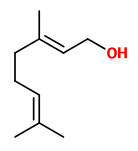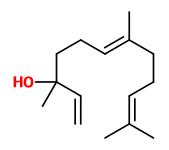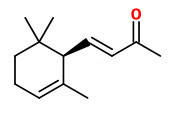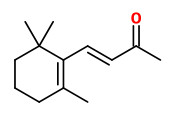Ilex paraguariensis A. St. Hil. - Aquifoliaceae - erva-mate (port.), yerba mate (span.), mate tree, Paraguay tea, Mate-Strauch, Mate-Baum, Yerbabaum, Paraguaytee
Evergreen shrub or tree, native in Brazil, Paraguay, and Argentina; leaves 6-20cm long, serrate; flowers small, white; fruit red, with 4-8 seeds.
Aroma concentrates (SDE) of green mate and roasted mate showed that 144 of the 250 components found were similar to those of Camellia sinensis tea, including linalool, α-terpineol, geraniol, nerolidol, α-ionone, β-ionone, and 2,6,6-trimethyl-2-hydroxycyclohexanone-related compounds. „High levels of 2-butoxyethanol were characteristic, and 3,3,5-trimethylcyclohexanone-related compounds, although present at low levels, were specific to mate flavor. Roasted mate contained more furans, pyrazines, and pyrrols as formed by maillard reaction during the roasting process.“
[Kawakami, Michiko, and Akio Kobayashi. „Volatile constituents of green mate and roasted mate.“ Journal of Agricultural and Food Chemistry 39.7 (1991): 1275-1279]
„Despite the health promoting properties of mate and other herbal teas, their characteristic flavours are still not well characterized. However, recent application of increasingly sophisticated analytical techniques, such as GC-MS, GC × GC, and GC × GC-qMS, have resulted in the identification of an array of volatile compounds in mate and other herbal tea infusions. The composition of these compounds was varied and depended on the manufacturing process and the starting raw materials. In the case of mate tea, the 10 main compounds identified were linalool, α-ionone, β-ionone, α-terpineol, octanoic acid, geraniol, 1-octanol, nerolidol, geranylacetone and eugenol. While these compounds have similarly been identified in Camellia sinensis, other herbal teas were characterized by the presence of a wide range of terpenes such as guaiacol, 4-vinylguaiacol, eugenol, citral, phenol, carvone, menthol, 1,8-cineole and citronellyl acetate. It is noteworthy that significant numbers of polycyclic aromatic hydrocarbons (PAHs) and other contaminants were identified in several of the mate tea infusions.“
[Lasekan, O., Lasekan, A., Flavour chemistry of mate and some common herbal teas. Trends in Food Science & Technology, Vol.27(1), 2012, 37-46]
Of 35 major volatile compounds identified by GC-MS in 18 yerba mate commercial brands from Argentina, Brazil, Paraguay and Uruguay, 16 odor active compounds were detected by GC-O analysis: Myrcene (herbaceous, sweet), octanal (citrus), 1-octen-3-one (mushroom), 6-methyl-5-hepten-2-one (mossy), (Z)-linalool oxide furanoid (flowery), (E,Z)-2,4-heptadienal (nutty), (E,E)-2,4-heptadienal (nutty), (E,Z)-3,5-octadien-2-one (mushroom)
(E,E)-3,5-octadien-2-one (mushroom), linalool (flowery), geranial (flowery), nerol (sweet), β-damascenone (apple), α-ionone (flowery), β-ionone (sweet), and (E)-4,5-epoxy-(E)-2-decenal (oxidized, metallic).
[Márquez, Victoria, et al. „Characterization of aroma-impact compounds in yerba mate (Ilex paraguariensis) using GC-olfactometry and GC-MS.“ Food research international 53.2 (2013): 808-815]
„The major constituents of the fresh leaf EOs were found to be 3-allylguaiacol (28.51%), linalool (17.61%), and methyl salicylate (5.36%), while those of green mate were 2,6-dimethyl-1,7-octadien-3-ol (9.77%), linalool (5.58%), and α-terpineol (4.67%). Furthermore, hazardous contaminants such as hydrocarbon isomers and PAHs (in particular, alkylated PAHs) were tentatively identified in green mate.“
[Polidoro, Allan dos S., et al. „Characterization of volatile fractions in green mate and mate leaves (Ilex paraguariensis A. St. Hil.) by comprehensive two-dimensional gas chromatography coupled to time-of-flight mass spectrometry (GC× GC/TOFMS).“ Microchemical Journal 128 (2016): 118-127]
„Soon after harvesting the leaves are briefly toasted at 300°C for about 1 min to avoi d fermentation
(inactivation of phenoloxydase) [Knöss 2005]. This procedure is called “sapeco”. So called “Green
Maté” is yi elded after drying at 80 -100°C/about 24 h, powdering and removing twigs. Sometimes, a
further roasting produces “roasted Maté”, in Brazil known as “chá mate”.
The drug contains purines like caffeine (0.5 -2.5% [Haaf 2004]), theobromine (0. 12-0.7% [Scherer et
al. 2002, Filip et al. 1998, Vasquez and Moyna 1986, Reginatto et al. 1999]) and none [Haaf 2004] or
small amounts of theophylline (0.1-0.4% [Ohem 1996, Mazzafera 1994]). Other investigations yielded
higher amounts of caffeine 0.1 to 2.7% and higher or smaller amounts of theobromine 0.6-2.17%
[Haaf 2004, Scherer et al. 2002, Schneider et al. 2006]. According the DAC 2004, the unroasted
leaves contain a minimum of 0.6% caffeine and the roasted leaves contain a minimum of 0.4%
caffeine.
Based on the plausible effects and the described traditional use, from the above mentioned indications
only the following indications are appropriate for a traditional use without the supervision of a medical
practitioner for diagnostic purposes or for prescription or monitoring of treatment: Oral use: Traditionally used for symptoms of fatigue and sensation of weakness. Traditional herbal medicinal product to increase the amount of urine to achieve flushing of the urinary tract as an adjuvant in minor urinary complaints.“
[Assessment report on . Ilex paraguariensis. St. Hilaire, folium EMA/HMPC/580545/2008, Committee on Herbal Medicinal Products (HMPC), 2010] PDF
„Numerous active phytochemicals have been identified in Mate tea that may be responsible for its health benefits. Among them, the 2 highest compounds are the polyphenols (chlorogenic acid) and xanthines (caffeine and theobromine), followed by purine alkaloids (caffeic acid, 3,4-dicaffeoylquinic acid, 3,5-dicaffeoylquinic acid), flavonoids (quercetin, kaempferol, and rutin), amino acids, minerals (P, Fe, and Ca), and vitamins (C, B1, and B2). Not only has Mate tea been shown to contain high concentrations of bioactive compounds, it has also been shown to be cytotoxic to human cancer hepatoma cells (HepG2), and can act as a catalytic inhibitor of topoisomerase II.“
[Heck, C. I., De Mejia, E. G., Yerba Mate Tea (Ilex paraguariensis): a comprehensive review on chemistry, health implications, and technological considerations. Journal of Food Science, Vol.72(9), 2007, 138-151]
PDF

Köhler,F.E., Medizinal Pflanzen, vol.3, t.60 (1890) plantgenera.org

Ilex paraguariensis, Selva Paranaense, Argentina (2022) © Nico Sánchez CC BY-SA 4.0 inaturalist.org





